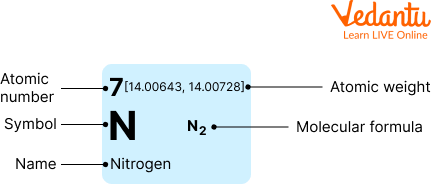




Overview of the Nitrogen
Have you ever wondered why the chip packets are so fluffed with some gas? What is the gas filled in those bags of chips? Does it harm our bodies? Does it spoil our food? The gas that is being talked about is called Nitrogen. It is used in food packaging because it displaces oxygen present here. It is a non-reactive gas used for varied purposes by humans due to its unique properties. Nitrogen is used for the production of fertilisers, nitric acid, dyes, etc. This gas is most abundant and immediate in our surroundings yet cannot be used by us directly. In this article, we will learn more facts about nitrogen, its properties of nitrogen and much more. So let’s start learning.

A Packet of Chips Filled with Nitrogen
Who Discovered Nitrogen?
We learnt what nitrogen is and where it is found in the above portion of the article. Who discovered nitrogen and identified and placed it as a unique element? 78% of the air in the atmosphere is nitrogen gas only. Daniel Rutherford discovered nitrogen. Rutherford discovered the element nitrogen officially in 1772.
Boiling Point of Nitrogen
The boiling point of Nitrogen is 195.8 degrees Celsius. And that is why Nitrogen stays as a gas in our atmosphere due to nitrogen's very low boiling point.
Characteristics of Nitrogen
Nitrogen is a gaseous element on the periodic table. Nitrogen is the most abundant gas in the earth's atmosphere, meaning it makes up the greatest portion of the gases we breathe in.
Nitrogen is a very major component in the bodies of both humans and plants. It is essential for their lives to continue and to translate into future generations.
Scientifically nitrogen is denoted as the alphabet N.
It is the seventh element on the periodic table.
Nitrogen has an atomic mass of 14 Atomic mass units.
Nitrogen has a density of about 1.25 grams per litre.
Nitrogen has two stable isotopes, which are N-14 and N-15. N-15 has one additional number of neutrons than that of N-15 in its atom.

Information About Nitrogen
Properties of Nitrogen
The properties of nitrogen element are as follows:
Nitrogen is colourless, odourless, and tasteless.
It is very active and can react very easily.
Nitrogen cannot be utilised or used by living organisms directly.
Nitrogen molecules support plant growth and contribute to animal protein synthesis.
When temperatures are very low, nitrogen turns into a liquid. In that state, it can freeze dry food and maintain the coldness of food throughout long-distance transportation.
Ammonia and nitric acid are the two most noteworthy nitrogen molecules used in industrial and commercial settings. Many additional nitrogen compounds are prepared using the gas ammonia. A liquid called nitric acid is used to make explosives, fertilisers, dyes, and pharmaceuticals.
Uses of Nitrogen
Nitrogen is a very useful element in various industries for varied purposes therefore, below are enlisted various uses of nitrogen:
Food Industry- Nitrogen gas is employed to provide unreactive conditions. Due to this, it is used to preserve foods.
Nitrogen in Bulb: Nitrogen is filled into the bulb because the bulb filament reacts easily when it comes in contact with air therefore, nitrogen provides an unreactive environment.
Fire Compressor: Nitrogen is used to make fire compressor systems
Aircraft: Nitrogen is also used as fuel in aircraft engines
Preservation: Nitrogen is also used to pressurise and preserve various drinking products.
Steel: Nitrogen is also used in steelmaking to increase the boiling point of the material being made, as the boiling point of nitrogen is very high.

Nitrogen Used as a Cooling Agent
Facts About Nitrogen
Here are some most interesting facts about nitrogen :
Nitrogen in its liquid state is very cold and can cause severe frostbite and damage to the skin if it comes in contact with liquid nitrogen.
Nitrogen is seventh on the list of most abundant elements found on earth.
About 3 per cent of our body mass is made up of nitrogen.
Fusion, a process that takes place deep inside stars, creates it.
Nitrogen plays a vital role in the formation and duplication of DNA or our genetic material.
Summary
To conclude all the learnings from this article, we can say nitrogen is one of the most important elements on earth. It is used in various life processes as well as industrial processes. Nitrogen is colourless, odourless and tasteless. It is an essential part of human DNA. we also looked at the element information of nitrogen and the boiling point of nitrogen which is as high as minus 195 degrees Celsius. Nitrogen is used in the food industry in bulbs, fire compressors, aircraft, etc. Then we also looked at some astonishing facts about nitrogen, like it makes up 3 per cent of the human body mass. Nitrogen can react very actively in nature. With this, we would like to end this article. We hope we were easy and understandable, and fun to learn with.
FAQs on Facts About Nitrogen
1. Where on earth is nitrogen found?
About 78 per cent of nitrogen on earth is found in the atmosphere, in the air we breathe. It can also be found in a dissolved state in some quantity in the earth’s crust. All living things on Earth, including plants and animals, have nitrogen in some quantity in their bodies. As nitrogen is an essential part of making both proteins and nucleic acids.
2. What is the nitrogen cycle?
Nitrogen fixing is a naturally occurring phenomenon of element cycling. Ammonia, nitrites, and nitrates are generated from free nitrogen when it is changed into other substances. Plants then absorb these substances and utilise them. Animals consume these plants and change the chemicals into other compounds that are useful to their bodies. When an animal or plant dies, its parts break down and release nitrogen into the soil. Animal waste also replenishes nitrogen in the soil. The cycle might then start over.
3. Enumerate isotopes of nitrogen.
Isotopes are elements with the same number of protons, whereas different ones. of neutrons. Nitrogen has two stable isotopes, Nitrogen-14 and Nitrogen-15, respectively. Nitrogen-14 makes up more than 99% of the universe's nitrogen.









